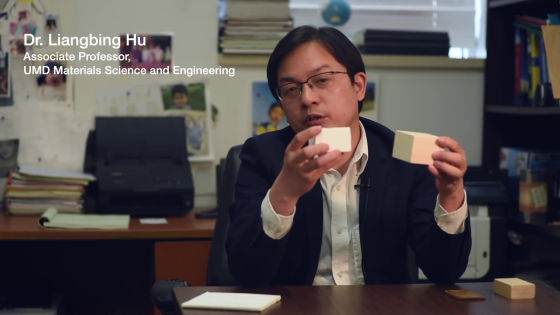Succeeded in turning wood into a new material that is stronger than steel & reflects heat and keeps the air cool

Although many modern buildings use materials such as cement, concrete, and steel, cement and concrete generate a large amount of carbon dioxide in the manufacturing process, and steel requires many resources. There is a drawback that Also, even after the construction is completed, heating and air cooling of the building are at the heart of the energy problem, and many ideas have been created to solve these building and building materials problems. Then, a new researcher announced that he had developed a material that is stronger than steel, reflects sunlight and radiates excess heat. This magical material is actually based on 'trees'.
Stronger than aluminum, a heavily altered wood cools passively | Ars Technica
https://arstechnica.com/science/2019/05/chemically-treated-wood-could-send-excess-heat-to-space/
A radiative cooling structural material | Science
https://science.sciencemag.org/content/364/6442/760
Wood is mainly composed of carbohydrates (polysaccharides) called cellulose and polymers called lignin . Lignin is not a single polymer but can be highly polymerized at random locations. Lignins, which can be chemically linked in various places, are very complex in structure and thus known to produce robust meshes.

Cellulose can be easily broken down into monosaccharides, but lignin is difficult to digest and degrade due to its variability. Conversely, it can be said that lignin produces 'hardness' that can not be achieved with cellulose alone.
The method announced in the new research is to put wood in hydrogen peroxide and compress the wood from which lignin is removed. Although this method seems to reduce the resistance of wood, assuming that lignin is generating the strength of wood, high density hydrogen is obtained by the interaction of oxygen / hydrogen groups hanging from sugar. A mesh of bonds is produced, and it is said that a wood stronger than ordinary wood is completed.
You can check how the new material is created and the features of the new material from the following movie.
Dr. Liangbing Hu of the University of Maryland who conducted the research has a new material on the left hand and a normal wood on the right. You can see that the color of the new material is bright white.

This is where wood is treated with hydrogen peroxide.

The completed one is white like paper.

The wood produced by the new method has been confirmed by various methods such as bending, stretching and impacting. In particular, tensile strength seems to have sometimes exceeded steel and titanium. With the development of new methods, there is also the possibility that wood will be used in the future, where it is usually impossible to use wood.
And, it should be noted that the wood produced by the above method has the property that it is hard to absorb the heat of the sun. Because hydrogen peroxide treated wood has the property that sunlight bounces back and spreads in the cellulose mesh, it becomes a white shade than ordinary wood on the same principle that angular sugar looks white, It seems to be harder to catch heat than wood. In fact, a researcher prepared a box made of ordinary wood and wood treated with hydrogen peroxide at a farm in Arizona, USA, and conducted an experiment to compare the temperature in the box. The results show that the temperature inside the hydrogen peroxide-treated wood box is more than 4 degrees lower even during the hottest hours of the day.
In addition, when researchers used past weather data to find out where in the 16 states in the United States this timber could be used as a model of an average designed apartment, this new timber was used in Atlanta, Las Vegas, Phoenix, etc. It has been shown that using it can reduce energy for facility cooling. Researchers say that covering existing buildings with hydrogen peroxide treated wood can reduce energy for cooling by as much as 35%.
Related Posts:







